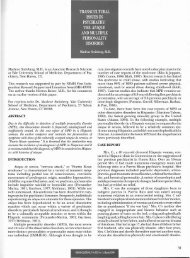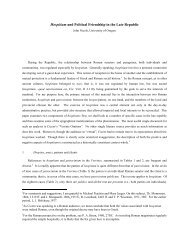~EGULAR SESSION - University of Oregon
~EGULAR SESSION - University of Oregon
~EGULAR SESSION - University of Oregon
You also want an ePaper? Increase the reach of your titles
YUMPU automatically turns print PDFs into web optimized ePapers that Google loves.
Honors. See HONORS COLLEGE, pages 120-123.<br />
BIOLOGY 135<br />
Graduate Work. The department <strong>of</strong>fers graduate work leading to the Master<br />
<strong>of</strong> Arts, Master <strong>of</strong> Science, and Doctor <strong>of</strong> Philosophy degrees. Candidates for<br />
higher degrees are expected to meet undergraduate major requirements, as determined<br />
by their undergraduate records and by examination, before advancement<br />
to candidacy for the degree.<br />
Facilities are available for graduate study in botany (plant morphology, cytology,<br />
anatomy, taxonomy, and physiology), ecology (plant and animal), genetics,<br />
marine biology, microbiology, physiology (comparative, general, and mammalian),<br />
and zoology (cytology, embryology, invertebrate, and vertebrate).<br />
Institute <strong>of</strong> Marine Biology. The <strong>University</strong> operates for the <strong>Oregon</strong> State<br />
System <strong>of</strong> Higher Education an Institute <strong>of</strong> Marine Biology at Charleston on Coos<br />
Bay on the <strong>Oregon</strong> Coast. The Institute is located in a setting providing access to<br />
an unusual variety <strong>of</strong> richly populated marine and terrestrial habitats. Under the<br />
guidance <strong>of</strong> an interinstitutional advisory committee, the Institute serves all units<br />
<strong>of</strong> the State System. A program <strong>of</strong> undergraduate and graduate studies is <strong>of</strong>fered<br />
during the summer session.<br />
Institute <strong>of</strong> Molecular Biology. A program <strong>of</strong> research and research instruction<br />
in areas <strong>of</strong> biology where phenomena can be understood in terms <strong>of</strong> the structure<br />
<strong>of</strong> molecules is conducted through the <strong>University</strong> <strong>of</strong> <strong>Oregon</strong> Institute <strong>of</strong><br />
Molecular Biology. See INSTITUTE OF MOLECULAR BIOLOGY (pages 115-116).<br />
LOWER-DIVISION COURSES<br />
Bi 101, 102, 103. General Biology. 4 hours each term.<br />
Principles <strong>of</strong> life science, illustrated by studies <strong>of</strong> selected organisms. 3 lectures;<br />
1 three-hour laboratory period.<br />
Bi 104, 105, 106. Biological Science (Honors College). 4 hours each term.<br />
Selected studies <strong>of</strong> biological principles, with emphasis on methods <strong>of</strong> observation,<br />
comparison, analysis, experiment, and synthesis in biological science.<br />
3 lectures; 1 three-hour laboratory period.<br />
UPPER-DIVISION COURSES<br />
(Bi 101, 102, 103 or equivalent is prereqllisite to all lIpper·division collrses in biology.<br />
Other prerequ-isites are indicated in the course descriptions.)<br />
Bi 311. Cellular Physiology. 4 hours.<br />
Cellular phenomena common to all organisms, including chemical processes<br />
<strong>of</strong> metabolism and membrane processes. Prerequisite: Ch 334.<br />
Bi 312, 313. Human Physiology. 3 hours each term, winter and spring.<br />
Required for majors in physical education, elective for others qualified. 2 lectures;<br />
1 three-hour laboratory period. Prerequisite: one year <strong>of</strong> chemistry.<br />
Soderwall.<br />
Bi 320. Cell Replication and Control Mechanisms. 4 hours.<br />
Structure and properties <strong>of</strong> macromolecules common to all living matter, and<br />
the control <strong>of</strong> their synthesis. Prerequisite: Bi 311.<br />
Bi 332, 333. Plant Morphology. 4 hours each term, fall and winter.<br />
Comparative study <strong>of</strong> the structure and life histories <strong>of</strong> representatives <strong>of</strong> the<br />
important plant phyla. Fall: ferns, fern allies, and seed plants; winter: algae,<br />
fungi, liverworts, and mosses. 3 lectures; 2 three-hour laboratory periods.<br />
Tepfer, Castenholz.<br />
Bi 334. Systematic Botany. 4 hours.<br />
Principles <strong>of</strong> plant classification; common plant families; collection and identification<br />
<strong>of</strong> <strong>Oregon</strong> plants. Cook.
















